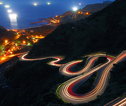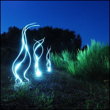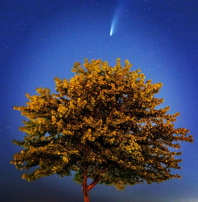Under Construction 
Contents:
General | Tips (Settings/equipment) | Light/Color | Special Effects | Light Painting | Astrophotography - moon, stars (tablet apps, telescope interfaces)
iPhone
These are guidelines for taking out door pictures, cityscapes, landscapes and Astrophotography (moon, planets, stars in the night sky, where things are too far away to use a flash.
Most of the tips below assume you have a high end rangefinder or a SLR.
However, you can do Astrophotography with an iPhone plus some apps and a tripod mount or telescope. See below.
General:
You may have to use manual focus and exposure, because most cameras will not be able to focus on a low light object such as a lunar eclipse and it will try to expose it to look like daylight. You will probably need to turn off the flash.
Why would you want to ruin a good eclipse by lighting it up with a flash. 
Setting time exposure on a Canon Rebel:
- Set Mode Dial to <M>
- Set shutter speed and aperture

Turn all the way to <BULB> for time exposure

- Set the exposure and take the picture
If you press the <DISP> button the time will be displayed
The exposure level mark will move as you change settings
Will get more noise than usual with time exposures.
Use <Menu>  Custom Function (C.Fn) to [Long exp. noise reduction] to [Auto] or [On] Custom Function (C.Fn) to [Long exp. noise reduction] to [Auto] or [On]
Hold the shutter button and it will count down then start the exposure as long as you hold the button down.
Tips:
- Equipment
- Tripod for time exposures of the sky
- Using a shutter cable release (bulb setting on your camera) that will allow you to hold the exposure open for as long as you need is advisable.
- A lens hood. To minimize lens flares from light entering at angles outside of your frame. e.g. street lights
- Lights - A pen light to see the controls on your camera.
A flashlight, flashgun, spot or flood light for brightening part of a scene or for light painting. Sometimes you'll want to draw attention to or simply lighten up an important part of the foreground.
- A stopwatch or other timer to manually time shots.
- A notebook to keep notes on settings and timing. My canon DSLR always shows 1 sec. in the EXIF data stored with image when using a cable release (bulb setting)
- A fixed focal length lens is less prone to flare
- Camera setup
- Digital autofocus lenses have a tendency to focus beyond infinity while appearing to match the infinity mark on the ring.
- Remove your UV filter; It will cause blaze or haze if you are taking pictures of street lights, transportation, automobile trails, moving cars , bridge lights etc.,
- Focus can drift because of temperature change. Check periodically.
- Heat currents on hot nights can produce apparent wobble.
Shooting straight up instead of toward the horizon will reduce the amount of atmosphere you are shooting thru, and give better results.
- The temperature of your CCD and lens has a big influence on your final shots, especially if you are using a compact camera with a small CCD. When you are planning to shoot at night, leave your camera gear outside for one to two hours before you use it - this will get the camera the same temperature as the surroundings and help get better shots. A cooler CCD will produce less noise.
- For the clearest shots, take a drive to the country to avoid light pollution in cities.
- Turn off your noise reduction; just reduces some detail on your images.
- White balance is really important. If you are shooting trailing lights, bridges, cityscape then you can use this settings. WB=incandescent +3 is usually good.
- Mirror lock may help to reduce wobble
- Exposure
- Astrophotography - large aperture F2-F2.8 (less depth of field) long 1.5 min. shutter speed
- Nightscape (buildings, people, ...) - small aperture F8-F16 (more depth of field) long 1.5 min. shutter speed
- Landscape - high f short exposure 1/100, high ISO
- Night scenes which contain artificial light sources should almost always have low-key histograms, otherwise these will have significant blown highlights
- High ISO and fast lens for shooting without a tripod
- Use low ISO because low light and long exposures produce noise
- Smaller apertures will create and exaggerate the star-like radiating shafts of light that can appear to emanate from small points of light in a scene.
- According to Eric Kim, if you are shooting scenes with motion (e.g. people walking) you need a lens with an aperture of 2.8 or faster.
- Post processing
- HDR (high dynamic range) and DRI (dynamic range increase) post-processing techniques are a great tool in your skill set for night photos
- Topaz Denoise can used to clean up your image.
Considerations/Composition/Special effects
Light/Color:
The human eye is more sensitive to luminescence and less sensitive to color in low light; the sensors in cameras is not. So, you may have to experiment to get things to come out the way you like.
 Special effects:
Special effects:
You can take advantage of the long exposure times required and get special effects like long ribbons of head or tail lights as cars move along a road.
See: Sconnie's "night" favorite pictures on VisualizeUs

 Painting a scene with light:
Painting a scene with light:
A flashlight or spotlight can be moved around on an object while the shutter is open to make it standout or add color. Click on images for source.
See:
10 Tips for light painting (Watch the video)
Orbs - Light Painting Photography Tutorial - YouTube
 Astrophotography
Astrophotography
Lenses/telescopes:
At AstroPix.com they say,
"The high resolution of digital sensors provide quite a challenge for normal photographic lenses. These lenses were made for general daytime photography. Shooting pinpoint light sources across a wide field if stars is the most difficult test possible for a camera lens.
Camera lenses have more elements (pieces of glass), up to a dozen or more, than telescopes with 3 to 4 elements.
Multiple elements in camera lenses lead to some light loss because there are so many air-to-glass surfaces, and additional contrast loss, even with multi-coating.
Camera lenses, however, can be used for shooting the stars! In most cases they must be stopped down a stop or two from wide open to improve coma, astigmatism and chromatic aberrations enough to produce usable stars.
Fixed focal length lenses are better because they have fewer elements.
Try to get a lens that is at least f/2.8 for fixed tripod shots so you can use relatively short exposures.
Telescopes are designed for night viewing. For them,
fast f/4 to f/5 focal ratios are generally best for lower power wide field observing and deep space photography. Slow f/11 to f/15 focal ratios are usually better suited to higher power lunar, planetary, and binary star observing and high power photography. Medium f/6 to f/10 focal ratios work well with either."
Search for Camera to Telescope Adapters
Techniques:
See Astrophotography Techniques at AstroPIX.com
Any exposure longer than 30 seconds will suffer "field rotation" or "star trailing" because of the rotation of the earth.
There are expensive motorized mounts that rotate the camera to compensate for the rotation of the earth.
See: Mounts for Astrophotography
Tablet apps:
There are several excellent night sky apps for your iPhone, droid or tablets which will identify objects stars, constellations and planets as you point your phone/tablet toward an area of the sky.
Camera to Telescope Adapters
Star Walk iPad
GoSkyWatch iPhone iPad
StarMap iPhone iPad
Google Sky Map Android
See: Apps for Stargazing: iPad/iPhone Apps AppGuide
iPhone:
With an iPhone you can use the SlowShutterCam app or Magic Shutter and a tripod mount to take time exposures.
The Night Camera app senses when the iPhone is steady before taking a picture.
iPhoto has a function for reducing noise, or you an use Noise Ninja (trial, win+mac), NDNoise (free, win+mac), Neat Image (trial, win+mac).
See:
iPhone Astrophotography | Dark Sky Diary
Need a Coffee Break: Night photography with iPhone?
Some examples:
 Pete Souza Instagram
Pete Souza Instagram
15 sec f4.5 iso 1600 w/ 85mm lens
My pictures:
2007 eclipse
Venus, Jupiter, Moon March 2012
Books:
Night and Low-light Photography, 2008, Jill Waterman
Links:
Night Photography Tips | digital-photography-school.com
Night DSLR Photography: Between Dusk & Dawn Hours | SmokinPhoto
Low Light Photography by CSP
Common Obstacles in Night Photography
Ten Tips for Top Quality Night Photos - Ten Tips - JPG
35+ Inspiring Nightscape photography and Tips
The Complete Guide To Shooting The Moon On A Budget | DIYPhotography.net
Night Photography & Light Painting Photography Tutorials
Astrophotography at SKY & Telescope
Return to Hobbies
last updated 11 Apr 2012
| 
 Pete Souza Instagram
Pete Souza Instagram